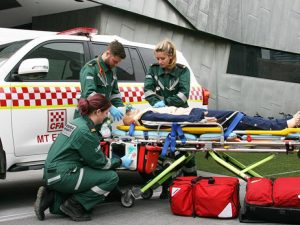Basic Life Support (BLS) Certification
- Description
- Curriculum
- Reviews
- Grade
Knowing the process of Basic Life Support (BLS) is critical in responding to life-threatening emergencies. The newest BLS course guidelines focus on doing several tasks simultaneously with a group process that promotes efficiency and minimization of errors.
This course will teach participants how to perform life support techniques including chest compressions, basic airway management, rescue breathing, AED use for defibrillation and more.
The course package includes:
– An online BLS study guide
– A BLS instructional presentation
NOTE – This course is for training in basic life support.
Who this course is for:
- Healthcare Professionals
- Medical Students
- Nursing and Allied Health Students
- Emergency Responders
- Anyone who wants to be prepared to save a life
What you’ll learn
- At the completion of this course the participant will be familiar with basic life support techniques used in response to common emergencies.
- Learn how to deliver high quality chest compressions, provide basic airway management, rescue breathing, and use of an automated external defibrillator (AED)
- You will be familiar with course content that complies with ILCOR BLS guidelines and be prepared to take an exam for BLS certification.
zzzBecome familiar with basic life support techniques used in response to common emergencies.
-
1Introducing Save A Life by NHCPS & the Disque FoundationVideo lesson
-
2Basic Life Support (BLS) ProviderVideo lessonThis lesson is locked because you haven't completed the previous one yet. Finish the previous lesson to unlock this one.
-
3Initiating the Chain of SurvivalVideo lessonThis lesson is locked because you haven't completed the previous one yet. Finish the previous lesson to unlock this one.
-
4Initiating the Chain of Survival part 2Video lessonThis lesson is locked because you haven't completed the previous one yet. Finish the previous lesson to unlock this one.
-
5General Concepts of Basic Life SupportVideo lessonThis lesson is locked because you haven't completed the previous one yet. Finish the previous lesson to unlock this one.
-
62020 Guideline ChangesVideo lessonThis lesson is locked because you haven't completed the previous one yet. Finish the previous lesson to unlock this one.
-
7One-Rescuer BLS/CPR for AdultsVideo lessonThis lesson is locked because you haven't completed the previous one yet. Finish the previous lesson to unlock this one.
The first lesson in chapter 2. This lesson discusses the BLS process and CPR steps associated with adults in a one-rescuer situation. The process is explained step-by-step, beginning with a situational assessment. Proper CPR steps are reviewed and explained.
-
8Adult Mouth-to-Mask VentilationVideo lessonThis lesson is locked because you haven't completed the previous one yet. Finish the previous lesson to unlock this one.This lesson discusses Adult Mouth-to-Mask Ventilation, which is the use of a mask to deliver breaths in one-rescuer CPR. The appropriate use is detailed step-by-step. These guidelines help to ensure CPR is administered properly in one-rescuer situations requiring the use of a ventilated mask.
-
9Adult Bag-Mask VentilationVideo lessonThis lesson is locked because you haven't completed the previous one yet. Finish the previous lesson to unlock this one.
This lesson discusses Adult Bag-Mask Ventilation, which is the use of a mask to deliver breaths in one-rescuer CPR. The appropriate use is detailed step-by-step. These guidelines help to ensure CPR is administered properly in one-rescuer situations requiring the use of a bag-mask.
-
10AED StepsVideo lessonThis lesson is locked because you haven't completed the previous one yet. Finish the previous lesson to unlock this one.
This lesson discusses Adult Bag-Mask Ventilation, which is the use of a mask to deliver breaths in one-rescuer CPR. The appropriate use is detailed step-by-step. These guidelines help to ensure CPR is administered properly in one-rescuer situations requiring the use of a bag-mask.
-
11Child VentilationVideo lessonThis lesson is locked because you haven't completed the previous one yet. Finish the previous lesson to unlock this one.
The third lesson of chapter 4, Child Ventilation. The first step is to ensure the bag-mask is the correct size. How to determine whether the mask is sized correctly is covered in the lesson. The proper use of the bag-mask is discussed.
-
12Rescue BreathingVideo lessonThis lesson is locked because you haven't completed the previous one yet. Finish the previous lesson to unlock this one.
The second part of chapter 7 discusses Rescue Breathing. Cardiac arrest is often preceded by respiratory distress and arrest. It is important to know this as an individual can be saved by preventing potential cardiac arrest.
-
13Infant CPRVideo lessonThis lesson is locked because you haven't completed the previous one yet. Finish the previous lesson to unlock this one.
-
14BLS AlgorithmsVideo lessonThis lesson is locked because you haven't completed the previous one yet. Finish the previous lesson to unlock this one.
-
15AssignmentAssignmentThis lesson is locked because you haven't completed the previous one yet. Finish the previous lesson to unlock this one.
-
16Final Exam5 questionsThis lesson is locked because you haven't completed the previous one yet. Finish the previous lesson to unlock this one.

Requirements
- No previous training or special materials are required







